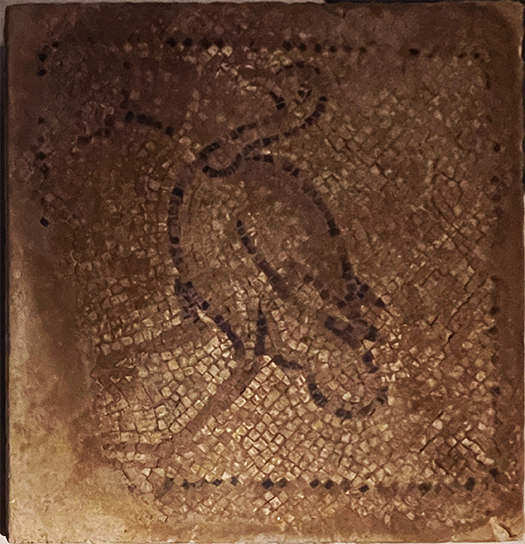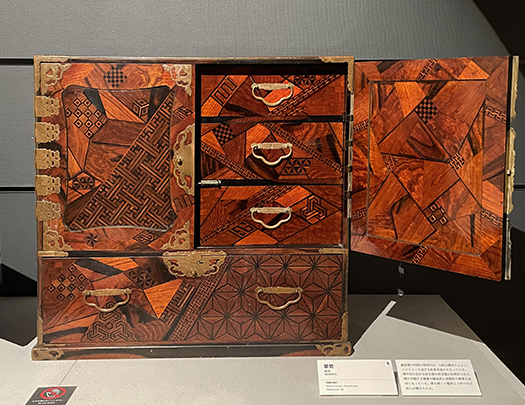

Macの環境を変えるのにはTime Machineというアップルが提供している
丸ごと引っ越しツールを利用することで比較的容易。
しかしAdobeとかMicrosoftなどでは独自にユーザー管理ツールがあるので
ソフト利用時に思わぬ困難が惹起したりすることがある。
一々、パスワードを要求されるのでその管理が重要になる。
今回はいくつかの「通過儀礼」を問題なくクリアできて比較的に順調。
しかしまぁ、1週間程度は様子を見るために旧環境マシンもそのまま保持。
昨日も社内環境での設定変更の結果、ブラウザ変更する必要が出るなど
およそ予期し得ない事態が起こってくるのですね。
さて本日は國學院大學博物館での特別展から。
先日も書いたのですが日本画コレクションの山種美術館からやや坂道を上がると
この博物館にたどりつくのであります。わたしの東京でのホーム。
いつの頃からか、このコースが習慣化しています。
大学の博物館というのはポピュラーなのかどうか知りませんが
歴史好きなわたしとしては母校の博物館はこころの栄養源なのです。
上の写真は「寄せ木細工手法のルーツ」的な展示。以下展示説明。
〜寄せ木細工の起源 寄せ木細工のルーツはエジプト18王朝のツタンカーメン
<BC1347-39>墓出土の木製手箱にまで遡れると言われ、
その後西アジア一帯で寄せ木技術を用いた作品が確認できる。
現在知られる日本最古の寄せ木細工は中国からの請来品で法隆寺宝物など30点。
これらは西アジア地域で制作されシルクロードを伝ってもたらされた。
しかしわが国では蒔絵や螺鈿の漆工芸が好まれたためか、その後
近世後期に至るまで盛り上がらず、その後再出発したとされる。
展示の石のモザイク画はアパメア遺跡(シリアBC3世紀ころ)時代のもので、
色違いの石材で鳥の模様を描き出しており、すでに同時代に制作されていた
寄せ木細工との共通性が見いだせるものといえる。その後、寄せ木細工技術は
西アジアからヨーロッパ全土に広がった。〜・・・
ということで、ことしはじめの「ポンペイ遺跡」の建築群展示などで
こうした石のモザイク技術が駆使されたことは学んでいた。
ちょっとしたことから人類の建材技術の長い歴史の一端を知った次第。
下の写真は江戸期になって盛んになった寄せ木細工による箪笥。
以前、小田原で箱根に由来すると思える在地の寄せ木細工技術を見学したが
こういった精緻な加工技術は日本オリジナルとも思える。
中国という現代史いや、世界史全体での最大の波乱要因が惹起する現代。
日本が生き延びていくためには、やはり産業技術を基盤にするしかない。
先人たちが成し遂げてきたこういった技術をさらに現代産業のすべての分野に
応用し、活用していくことがキモなのだと思った。
English version⬇
The human culture and technology of Yosegi-zaiku
Considering the undeniable contemporaneous symbiosis with the highly dangerous dictatorial communist state of China, Japan has no choice but to further hone its technological capabilities to survive. …….
Changing the Mac environment is relatively easy by using Time Machine, Apple’s
It is relatively easy to change the Mac environment by using the whole move tool provided by Apple called Time Machine.
However, Adobe and Microsoft have their own user management tools
This can cause unexpected difficulties when using software.
Since a password is required at every step, it is important to keep track of it.
This time, we were able to clear several “rites of passage” without any problems, and things are going relatively well.
However, the old environment machine is still there to see how it goes for about a week.
Yesterday, as a result of a configuration change in the internal environment, we had to change our browser.
Unexpected things happen, don’t they?
Today, I would like to start with a special exhibition at the Kokugakuin University Museum.
As I wrote the other day, if you walk up a little slope from the Yamatane Museum of Art, which has a collection of Japanese paintings, you will reach this museum.
I have already written about it the other day. This is my home in Tokyo.
I don’t know how long I have been following this course, but it has become a habit.
I don’t know if university museums are popular or not, but as a history buff
But as a history buff, the museum at my alma mater is a source of nourishment for my mind.
The photo above is an exhibit on the “Roots of Yosegi-zaiku (marquetry) Techniques. Here is the explanation of the exhibit.
〜The origin of marquetry The origin of marquetry is Tutankhamun of the 18th Dynasty in Egypt.
<The roots of marquetry can be traced back to the wooden handbasket excavated from the tomb of Tutankhamun of the 18th Dynasty in Egypt (1347-39 BC).
Since then, works using yosegi-zaiku techniques can be found throughout Western Asia.
The oldest known Japanese yosegi-zaiku work is a collection of 30 pieces from China, including the Horyu-ji Treasure.
These were produced in West Asia and brought to Japan via the Silk Road.
In Japan, however, maki-e and mother-of-pearl inlay lacquer crafts were favored, and the popularity of these crafts did not increase until the late modern period.
However, in Japan, makie lacquerware and mother-of-pearl inlays were favored, and the craft did not gain momentum until the late modern period, after which it is said to have been revived.
The stone mosaics on display are from the Apamea site (Syria, 3rd century BC).
The mosaics are made of stone of different colors and depict bird patterns, and it was found that they have something in common with marquetry that was already produced in the same period.
It can be said to have something in common with marquetry that was already being produced in the same period. Later, marquetry techniques
spread from Western Asia to all over Europe. 〜The first time I saw a piece of marquetry, I thought, “I’ve never seen anything like this before.
The stone mosaic technique was used in the architectural complexes at the ruins of Pompeii at the beginning of this year.
I had learned that this kind of stone mosaic technology was used in the architectural complexes of the “Pompeii ruins” at the beginning of this year.
I learned about the long history of human technology of building materials from this little thing.
The photo below shows a tansu (chest) made of marquetry, which became popular in the Edo period (1603-1868).
I had previously visited Odawara to see a local marquetry technique that seems to have originated in Hakone.
This kind of exquisite workmanship seems to be a Japanese original.
The present day is marked by China, the most turbulent factor in modern history, or even in world history as a whole.
In order to survive, Japan has no choice but to build on its industrial technology.
We must further apply and utilize these technologies that our predecessors have achieved in all areas of modern industry.
The key is to further apply and utilize these technologies that our predecessors have achieved in all fields of modern industry.
Posted on 11月 3rd, 2022 by 三木 奎吾
Filed under: 住宅マーケティング, 住宅性能・設備







コメントを投稿
「※誹謗中傷や、悪意のある書き込み、営利目的などのコメントを防ぐために、投稿された全てのコメントは一時的に保留されますのでご了承ください。」
You must be logged in to post a comment.